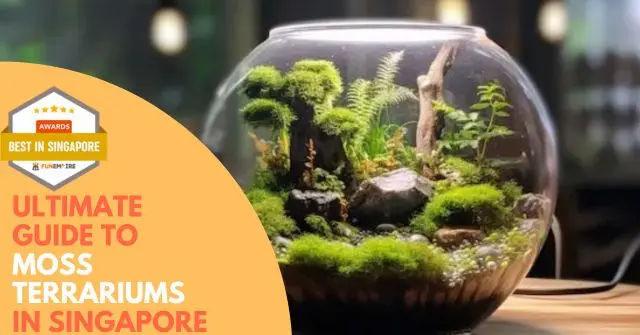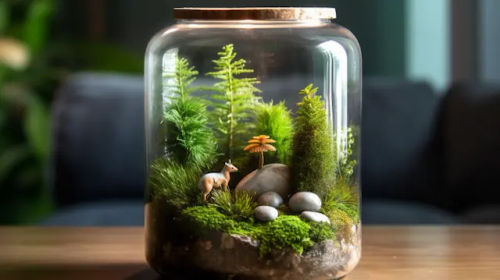Moss Terrarium Singapore

Moss terrariums have become a houseplant-du-jour for bringing nature indoors. They’re also excellent for Singapore, an urbanised country where it can be difficult to find greenery.
DIY moss terrariums, sometimes called mossariums, are the newest decorative, low-maintenance indoor plants – and nature-inspired décor elements.
This step-by-step guide of the best moss terrarium in Singapore for 2025 will discover the moss terrariums and cover how to create them, along with tips on the growth process.
Beginner or pro gardener, discover all to create your self-sustaining ecosystem!
Quick Summary
- Understanding Moss Terrariums: A Moss Terrarium is a mini ecosystem. Closing a terrarium will create a sealed environment for moss to thrive depending upon their needs.
- How to get started with Moss terrariums in Singapore: you will need a sealed glass container, light and good light, and the right moss. There are ready to use DIY kits available too.
- How to design your moss terrarium? Creating an aesthetically pleasing moss terrarium requires selecting the correct type of container and any decorative elements, all of which opens up an opportunity to provide additional space for moss to grow.
- How to Care for Moss Terrariums in Singapore In terms of maintenance, moss terrariums require little effort. You simply mist the terrariums occasionally and cut anything that you think is overgrown moss.
Understanding Moss Terrariums

Moss terrariums are small worlds of visually appealing mosses, captivated in a glass tower of living culture.
A closed terrarium is self-contained, with the moisture being recycled, and the mosses therefore are in the unique microclimate of the closed terrariums that allow for plant growth. A different species of moss is needed depending on how much light, moisture and heat it needs.
In addition, the right soil composition provides the nutrition and drainage that help moss to grow.
Getting Started with Moss Terrariums in Singapore

- Choose the right glass jar: Find a clean glass jar that is wide enough to provide sufficient air circulation and sunlight penetration. Consider size and shapewhich fits your desired aesthetic. A glass jar enables the self-sustaining ecosystem to be seen clearly.
- Mix the soil: mix peat moss, perlite and activated charcoal to create this well-draining soil mix that provides nutrients and adequate aeration for plants to thrive in a sealed terrarium.
- Pick a moss: Choose mosses that can be preserved in a sealed terrarium without much ventilation – and are also found in Singapore. Some things to pay attention to when choosing moss are the light requirements, moisture, and temperature.
- Add decorative elements (optional): If you want to add extra beauty to your moss terrarium, you can add some decorative elements such as rocks, driftwood, or even figurines. You can arrange these decorative elements in an aesthetic way to create a wall-like moss or enhance the look of your terrarium.
- Plant the moss: Select the moss, place it in the soil mix that is firmly in place in the glass container, leaving plenty of space to stretch out and expand and grow. You can make this moss wall fancier by gluing the moss you have chosen to one side of the above-mentioned container.
- Spritz and sustain moisture: Spritz the moss and soil lightly with water until the top inch or so of soil feels ever so slightly moist. Maintaining the perfect moisture level is key to the self-sustaining microcosm in your sealed terrarium. Don’t overwater or mold will develop.
- Location: Pick a proper place. A moss terrarium does best in indirect sunlight and moderate temperature with the air flowing smoothly and no forced drafts in it. Make sure you place your terrarium in a proper place.
Designing Your Moss Terrarium

When creating a visually stunning moss terrarium, you have the opportunity to exercise your creativity. Think about the shape and the size of the glass container before planning your layout.
On one side of the container, attach the moss for a colourful moss wall. Play with the height of the container, whether with round jars that sit tall on a shelf, hanging balls to bring plants right over your head, or geometric glass boxes.
Varying the size of the mosses will really help it to look decorative and natural; other decorative inclusions – such as smooth pebbles, tiny gnomes, tiny figurines or delicate fairy lights – should simply be something you enjoy, or that bring association to your terrarium. Don’t overpack your terrarium, so you have room to play and can watch your mosses thrive.
Caring for Moss Terrariums in Singapore

- Watering: Spritz the bonsai terrarium lightly (it should destroy ants, but don’t worry, this is normal!) when a fingernail pressed into the top soil layer feels dry, never “ soggy”. Beware that water sitting in the terrarium for too long can result in waterlogging and death of the moss. The right amount of moisture is what keeps the moss alive and growing.
- Light: Place in an area away from direct sunlight. Bright sun will dry out or burn the moss. Find a place where the terrarium can receive the light it needs.
- Monitoring humidity: Moss likes it humid. See how humid it is in the terrarium and maintain a comfortable medium level by sometimes spraying the moss and the side of the terrarium container. This will help create a good growth environment for moss.
- Keep things from getting congested: Make sure your moss has plenty of room to breathe. If things get overcrowded, then the air can’t flow properly, and mould or other issues might arise. Don’t trim your moss too close. Let it have some room to spread within the container.
- Pests and maintenance: Check for signs of pests such as fungus gnats, spider mites and the like in your terrarium regularly. Address any pests by using natural pest control methods if you find yourself in an infestation. Remove all dead branches and leaves to make sure your environment is clean and safe for moss.
- Temperature: Moss likes temperate conditions. Excessive temperature fluctuations or drafts are not recommended, as they can put your moss under stress and hinder its growth. Find a place for your terrarium with a constant temperature.
Moss Terrarium Singapore
Crafting your moss terrarium is a rewarding and mesmerizing endeavor.
This self-contained ecosystem could be built with the right care, resources and effort.
This manual provides all the details – from choosing proper soil blend to picking decorative accents – to help you create your own moss terrarium that will fit your personality and physique. Start your moss terrarium project today, because it’s time to express yourself through gardening.
Good luck on your moss terrarium project! May you create a vibrant and beautiful moss garden.
Check out our related articles below:
- Ultimate Guide To Building A Closed Terrarium Singapore (2025)
- Ultimate Fittonia Care Singapore Guide (2025)
- Ultimate Succulent Terrarium Singapore Guide (2025)
Frequently Asked Questions (FAQ)
In case you have some question on moss terrariums in singapore. Here is a FAQ on Moss Terrariums In Singapore that would help solve your questions.
Is moss odorless?
Moss is known to be odorless and does not attract insects. These features make it ideal for creating beautiful terrariums.
Are moss plants used for purifying air and water?
Yes. Moss plants are natural purifiers that can treat waters with high phenol or heavy metal content. There are also specific moss plants that can tolerate high salinity with low humidity and strong sunlight.
Is it safe to leave moss terrarium unattended?
Yes. Moss terrarium is a living ecosystem with natural stability. Interference from external factors must be kept to a minimum while the water balance must be maintained.
What are some of the types of moss you can use for a terrarium?
There are several different types of moss used in terrariums. Some are used for their unique textures, different growth habits, colour hue, all while enhancing the terrarium. Popular varieties include Sphagnum Moss, which holds a lot of water and is often used as a bottom layer to help keep relative humidity up inside the terrarium; Sheet Moss (Hypnum), used for creating beautiful, densely foliaged, spreading, green carpets; Mood Moss (Dicranum), which forms thick clumps of bright green, miniature moss; Club Moss (Selaginella), also called stone club, almine, or star club, which could be used to bring the feel of a miniature fern or pine tree into your moss terrarium; and Haircap Moss (Polytrichum), which is upright-growing, with its long, narrow green spikelets creating an interesting vertical element. Each type of moss has its own specific care requirements, but all generally thrive in a humid, indirect light environment, like you would find in a terrarium.
How can I ensure I have a healthy water cycle in my moss terrarium?
Water is crucial to any successful living plant terrarium. When creating the water cycle in your stone garden, we need the water to mimic a humid environment. A balance should exist between over-watering and under-watering. It is important to water every two-three days in open terrariums (always check for water in soil drying out – add the water if needed), or generally less in a closed terrarium, especially if you start to notice water condensation on the glass from too much water growth inside.



